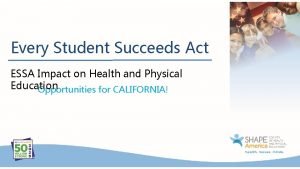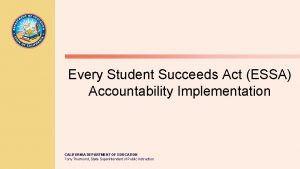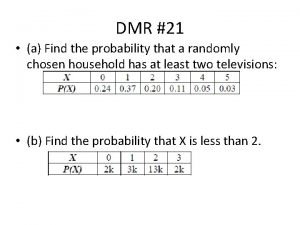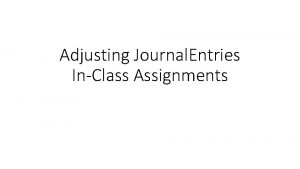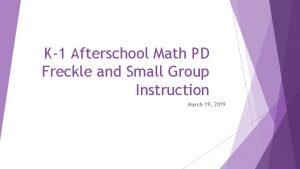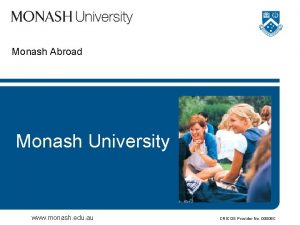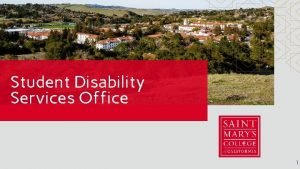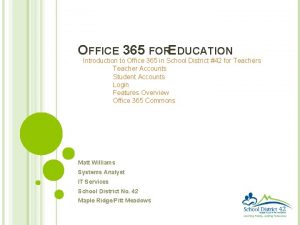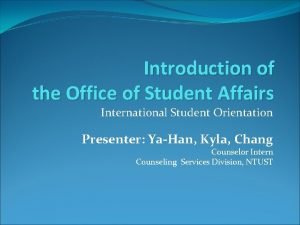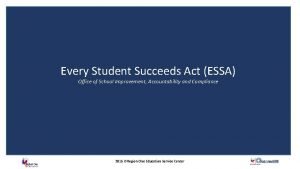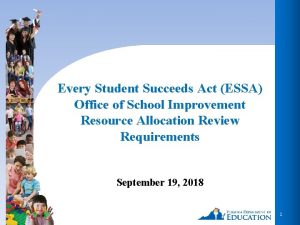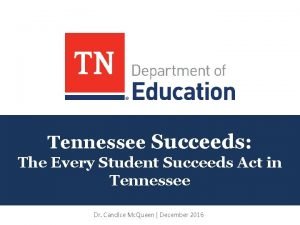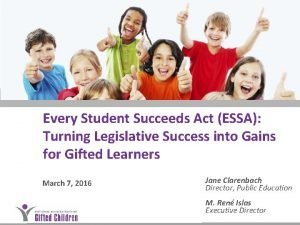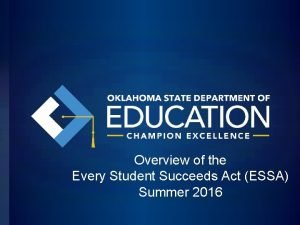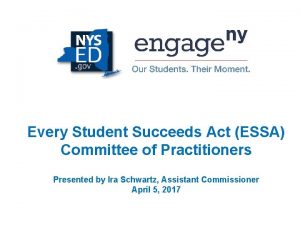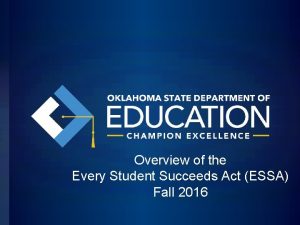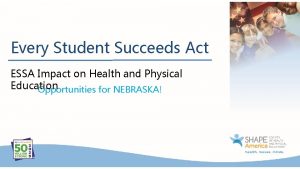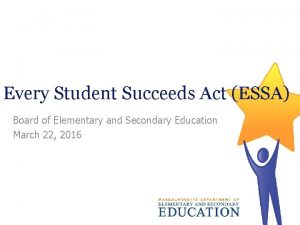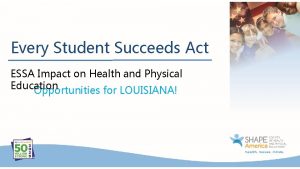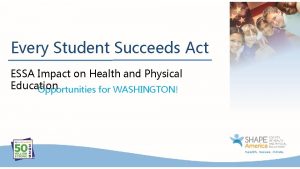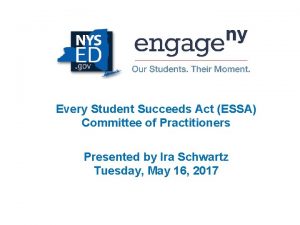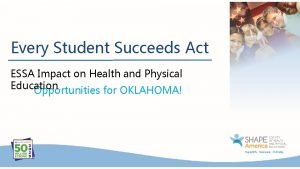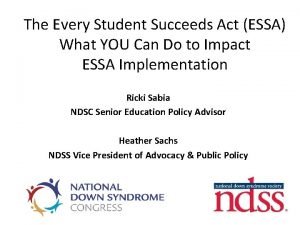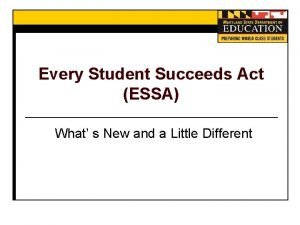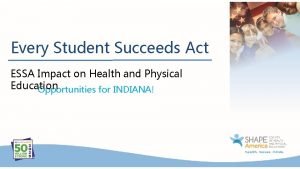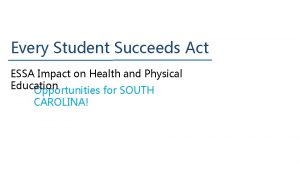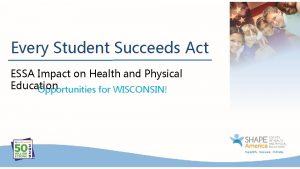Every Student Succeeds Act ESSA Roy Stehle Office


























- Slides: 26

Every Student Succeeds Act ESSA Roy Stehle Office of Federal and State Accountability 803 -734 -8118 rstehle@ed. sc. gov

Every Student Succeeds Act • The reauthorization of the Elementary and Secondary Education Act (ESEA) was signed into law in December 2015 as the Every Student Succeeds Act (ESSA). • ESEA was first passed in 1965 as part of Lyndon Johnson’s “War on Poverty” program. • The purpose is to ensure that all students have a fair, equal, and significant opportunity to obtain a high-quality education and reach, at a minimum, proficiency on challenging state academic achievement standards and assessment. • There is special emphasis on at risk subgroups of students.

Every Student Succeeds Act • South Carolina receives around $270, 000 in ESEA funds. • 2016 -17 will be a transition year for the major programs for ESSA. • To implement ESSA, South Carolina will submit a Consolidated State Plan to the US Department of Education (USED). • The ESSA Consolidated State Plan will support the Profile of the South Carolina Graduate.


ESSA Overview • There are state activities, national activities, formula and competitive funding, and requirements and assurances for the various ESSA programs. • Title I programs Parts A-D receive the largest share of the ESEA funding. • Title I includes requirements for college and career ready standards and assessments. • Title I also incudes requirements for a single state accountability system and requirements for school improvement.

ESSA Overview • Title I programs include Part A, Basic programs; Part B, State assessment; Part C, Migrant programs; and Part D, Neglected and Delinquent programs. • Local Education Agencies (LEA’s) and schools receive the majority of the ESEA funding. • Title II Part A – Preparing, Recruiting, and Training Teachers, Principals, and Other School Leaders • Title III – Part A - English Language Acquisition • The English Learner (EL, ELL, ESOL) program is a core instructional program supplemented by Title I and Title III.

ESSA Overview • Title IV – 21 st Century Schools Part A – Student Support and Academic Enrichment Grants (new) Part B - 21 st Century Community Learning Centers Part C – Charter Schools Part D – Magnet Schools Part E – Family Engagement

ESSA Overview • Title V – Flexibility and Accountability Part A – Transferability Part B – Rural Education: Rural Low Income School Program • Title VI – Indian, Native Hawaiian, and Alaska Native Education Part A – Indian Education • Title VII – Impact Aid

ESSA Overview • Title VIII – General Provisions Part A – Definitions Part B - Flexibility in the Use of Funds Part C – Coordination Part D – Waivers Part F – Uniform Provisions Private School, MOE, Civil Rights, Sense of Congress, Etc. • Title IX – Homeless and Other Laws Homeless Preschool

ESSA Overview • English Learner accountability is now in Title I instead of Title III. • Increased emphasis is placed on at-risk subgroups including homeless, foster care, and migrant children. • Emphasis is placed on at-risk students not being taught by inexperienced, out of field, and ineffective (IOI ) teachers. • The Highly Qualified (HQ) requirement for teachers has ended. • Instructional paraprofessional qualifications are still required for working in Title I funded schools.

ESSA Overview • States have greater flexibility under ESSA than under No Child Left Behind. • The test for supplement, not supplant will change. • Increased emphasis is placed on professional development for teachers and school leaders. • Most ESEA Flexibility Waiver provisions expire August 1, 2016.

ESSA Consolidated State Plan Components • Cross cutting components include Consultation and Coordination Challenging Academic Standards and Academic Assessments Accountability, Support, and Improvement for Schools Supporting Excellent Educators Supporting All Students • Specific information formula grant programs include Title I, III, IV, V, and Homeless.

ESSA Consolidated State Plan Tentative Timeline • June – Development of State Management Team, Steering Committee, and workgroups. • Six workgroups include the following: Consultation and Coordination; Challenging Academic Standards and Academic Assessment Accountability, Support, and Improvement for Schools; Supporting Excellent Educators, Supporting All Students; and Specific ESSA Program Plans (Title I for example). • June through July - Steering Committee and workgroups will determine assignments as they relate to the development of a draft framework. • July through August - Completion of workgroup assignments and review by Steering Committee.

ESSA Consolidated State Plan Tentative Timeline • August - Development of the SC draft framework. • August through September - Senior staff reviews, provides feedback, suggests adjustments/approves draft framework. • September through November - SCDE revises framework based on stakeholder input including the State Board of Education, EOC, and Legislature. • Thirty day review period – Governor’s Office. • December – Complete draft framework and convert to USED templates.

For More Information & To Submit Comments • The South Carolina Department of Education is engaging stakeholders in the development of components of the consolidated plan. • Stakeholder engagement will occur throughout the development of the plan (through November 2016). • The Department’s intent is to have the consolidated state plan framework completed by December 2016. • The Department intends to submit to the USED by March 2017 (or earlier). • Please go to the SCDE’s website under Hot Topics and follow the ESSA link. There are ESSA resources and an e-mail address to submit comments. Please submit your comments at http: //ed. sc. gov/newsroom/every-studentsucceeds-act-essa/.

Supplement, Not Supplant According to federal guidance: LEAs may use Title I funds only to supplement or increase the level of funds that would, in the absence of Title I funds, be made available from non-federal sources for the education of students participating in Title I programs.

Supplement, Not Supplant ~In plain language - Please~ • Another way to look at supplement, not supplant is to ask the question - what would districts and schools be required to offer in the absence of any federal funding? For example – the state required Defined Minimum Program for elementary, middle, and high schools. • Title I funds (and most federal funds) should be used in addition to state and/or local funding and not in the place of state or local funding. • Title I funds should not be used to meet other federal requirements (Title III, IDEA, etc. )

How to Determine if Activities are Supplemental • Testing for Presumptions of Supplanting: – Is it required by the state, district, or federal statute or regulation? – Are the same services provided for in non. Title I schools or students with (nonsupplemental) state/local funds? – Were these activities paid for in prior years with state/local funds?

Other Questions to Consider • Are the Title I schools receiving similar services provided for by state/local funding as non-Title schools? • Are Title I schools receiving their “fair share”? • Are the Title I schools being treated comparably (similar positions, technology, etc. )?

Supplanting Defense/Rebuttals • Similar Title I – like activity is funded in a non. Title school with supplemental funding, such as: – State At-Risk Funding – Discretionary Grant – Possibly, other funds that all schools are not eligible – This is generally known as the “exclusion” rule to supplement, not supplant. – An example might be an afterschool program funded with Title I funds at Title I schools and funded with state At Risk funding at non Title I schools.

Supplanting Defense/Rebuttals • Activities funded in prior year with state/local funds – However, the state/local funds used to pay for activities were reduced/eliminated and during budget prioritization the activities are to be eliminated • Document in Board agendas, minutes, etc. • Document via directives from the state (funding levels, allocations, etc. ) • Budget reports/meetings

Supplanting Defense/Rebuttals • Activities required by local, state, or federal statute • This presumption of supplanting is almost always not rebuttable. It is presumed that in the absence of federal funding, the district/school would be required to do the activity anyway. • Basic ESOL programs would be a good example of a program that districts would have to provide in the absence of any federal funding.

Supplemental Title I Activities • Common supplemental uses of Title I funds: – Decreasing class size (below state requirements) – Providing extra supplies/materials – Providing additional professional development – Extending learning time (before/after school or summer school) – Funding extra support services - nurses, guidance counselors, etc. – The greatest flexibility for use of Title I funds is in the schoolwide project. Always call your Title I Program Contact to get an opinion on supplement, not supplant issues.

Proposed SNS Regulation – Districts will develop a methodology for demonstrating that Title I funded schools receive their fair share of state and local dollars. – Compliance by December 2017 or plans to transition to the new SNS by 2019 -20. – There are four proposed methodologies discussed in the proposed regulation. 1 - A weighted funding formula that provides additional resources for students with disadvantages such as EL’s and Special Needs students. 2 - A formula that allocates resources, including staff and non -personnel resources directly to schools.

Proposed SNS Regulation 3 - An alternative funds-based test developed by the state and approved by a peer review panel that is as rigorous as the first two options. 4 - A methodology selected by the district that ensures per-pupil funding in each Title I school is at least as much as the average per -pupil funding in non-Title I schools. – SC may be able to develop an allocation method based on MOE, Comparability, weighted per-pupil funding, a staffing formula, meeting the defined minimum program as required in state regulations, and defining what funds we would use for the allocation method. – The difficulty will be if the SCDE/LEA has to compare state and local expenditures as opposed to what was allocated. – The SCDE will pull together some program, finance, and auditing experts to suggest methodologies.

Questions
 Every student succeeds act california
Every student succeeds act california Every student succeeds act california
Every student succeeds act california S sonora exemples
S sonora exemples Ethnocentric geocentric polycentric regiocentric
Ethnocentric geocentric polycentric regiocentric A professional soccer player succeeds in scoring
A professional soccer player succeeds in scoring Every nation and every country
Every nation and every country Microsoft vision statement
Microsoft vision statement Every knee shall bow every tongue confess
Every knee shall bow every tongue confess Every rotarian every year
Every rotarian every year Every nation and every country
Every nation and every country Every picture has a story and every story has a moment
Every picture has a story and every story has a moment Every child every day
Every child every day Macbeth act 3-5 summary
Macbeth act 3-5 summary Every student deserves a great teacher
Every student deserves a great teacher Qs 3-6 prepaid (deferred) expenses adjustments lo p1
Qs 3-6 prepaid (deferred) expenses adjustments lo p1 How was your last weekend
How was your last weekend We ...... a big piece of wood last saturday. (see)
We ...... a big piece of wood last saturday. (see) Clearinghouse student tracker
Clearinghouse student tracker Class maths student student1 class student string name
Class maths student student1 class student string name National student clearinghouse student tracker
National student clearinghouse student tracker Https://student.freckle.com/
Https://student.freckle.com/ Teacher good morning class
Teacher good morning class Sls
Sls Monash uni study abroad
Monash uni study abroad Smc students with disabilities
Smc students with disabilities Sd42 student login office 365
Sd42 student login office 365 Student affairs office
Student affairs office
